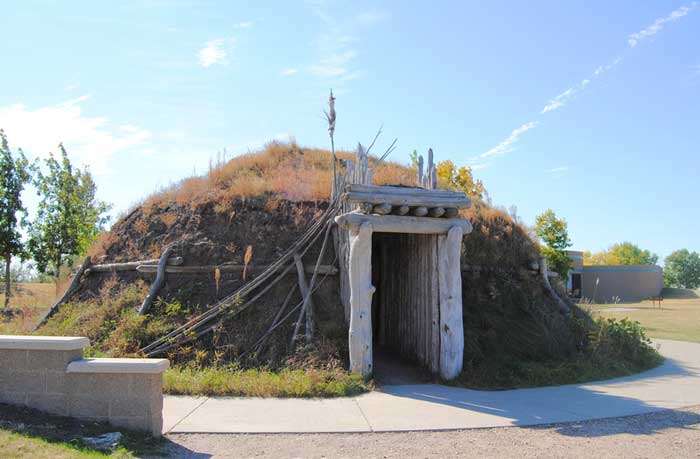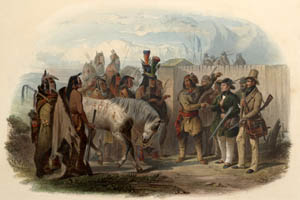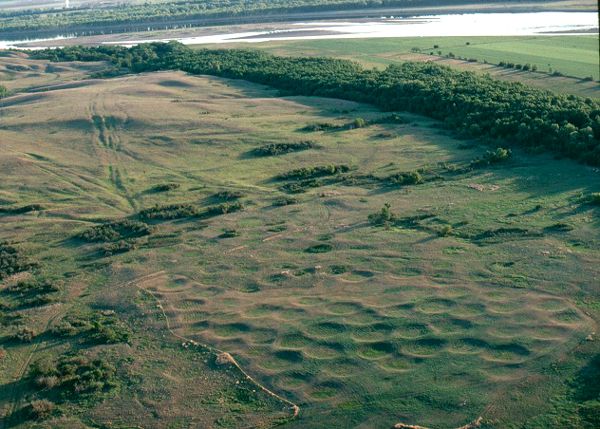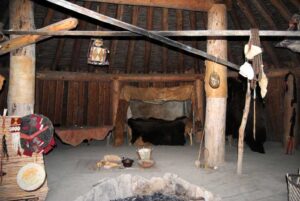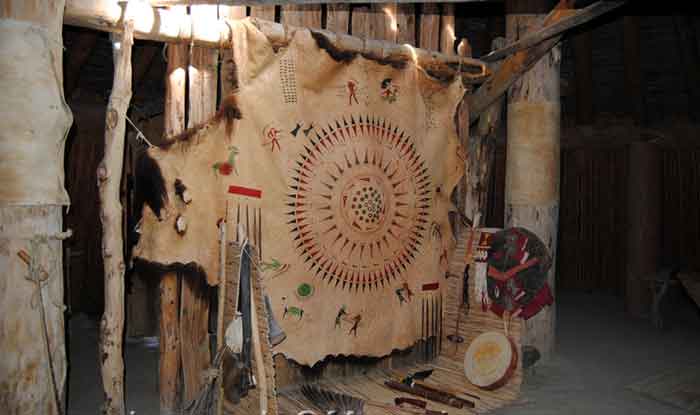Where the Knife River flows into the Missouri River in North Dakota, a diverse mix of rich wetlands, hardwood forest, and river bluffs stands in stark contrast to the endless miles of rolling prairie. The Upper Missouri River Valley was a lifeline winding through a harsh land.
The Knife River region has been home to people for perhaps 11,000 years. Though very few objects remain to interpret the cultures of the people who lived here, early written records and large quantities of cultural material document how the Hidatsa lived in earth lodge villages overlooking the Knife and Missouri Rivers for 500 years. They developed a prosperous way of life in harmony with nature and the cycle of the seasons.
In years past, this diverse environment supported a sedentary agricultural lifestyle unique to the Northern Plains. Hidatsa women grew corn, beans, squash, and sunflowers in the river bottomlands while they built earth lodges on the high terraces overlooking the river. Hidatsa men hunted bison on the vast open prairie and collected fish from the rivers.
The center of Hidatsa’s life was the village. With clusters of earth lodges so close they almost touched, each village supported a distinct community with its own dialect and customs. Their earth lodges, called “awahte,” were made of earth and wood. Built by the women in the village, each finished lodge would be 30-60 feet in diameter and 10-15 feet high. It would take approximately 7-10 days to complete an earth lodge from start to finish, and it would last around ten years. After the lodge was completed, a feast was given to thank all who had assisted.
An earth lodge housed 10-20 people, usually sisters and their families. The beds were located around the outer ring, between the support poles. Personal items were kept under one’s bed. General use items for the lodge occupants were kept on raised platforms similar to the bed frames. If more room was needed and it was not time to construct a new earth lodge, a smaller lodge could be built adjacent to the main lodge and connected with a short passage. This was called a twinning lodge.
A shrine for the very spiritual Hidatsa people could be found at the back of the lodge. The shrines varied in size, depending on what space was needed to care for the sacred objects it would house. The area between the shrine and the fire was sacred and not to be passed through. Corrals for horses were built inside each earth lodge, but these housed only the best and most prized war and hunting ponies brought in at night to protect them from theft and harsh weather. Stallions and mares were kept outside on opposite sides of the door. A small sweat lodge, an important part of Hidatsa life, was also built inside the lodge, usually to the right of the entrance near the corral. The sweat lodge was used for both ceremonial and practical purposes.
Villages of up to 120 earth lodges were constructed on the terrace above the Missouri and Knife Rivers. These permanent dwellings were owned and maintained by the women of the tribe. Because of their successful mastery of agriculture, these people could maintain a relatively non-migratory village life.
At some point, the Mandan and Arikara joined the Hidatsa in settled villages south along the Missouri River. Together, these three groups pioneered agriculture on the Northern Plains while hunting bison and gathering wild edibles. Despite their links as earth lodge peoples, conflict and competition were not unknown between these three communities.
The site was a major Native American trade center for hundreds of years before becoming an important marketplace for fur traders after 1750. Tribes across the Northern Plains journeyed to these permanent villages to trade, socialize, and make war. The Sioux, Cheyenne, Crow, Assiniboine, Ojibway Indians, white traders, explorers, and artists made the Knife River Indian Villages an exciting and cosmopolitan place. Foreign visitors also brought new diseases that dramatically altered communities and cultures, eventually ending the traditional lifestyle in the Knife River region.
Log and frame houses began to replace the earth lodge in the late 1800s, and today, the descendants of the earth lodge dwellers live in modern-style homes on the Fort Berthold Indian Reservation.
Today, the Knife River National Historic Site protects the remains of three large Hidatsa villages – Awatixa Xi’e Village, Awatixa Village, and Hidatsa Village. The round earth lodge depressions and midden mounds at these sites only hint at the vibrant cultures that once flourished here.
Awatixa Xi’e Village, also known as the Lower Hidatsa Village, was established as early as 1525 and was continuously occupied until about 1780-1785. Home to the Awatixa Hidatsa subgroup, the village covered an area of about 10 acres and contained at least 50 earth lodges. An estimated 500-600 people lived there until it was abandoned after a smallpox epidemic swept through the villages. The survivors moved away to other locations and established the short-lived Rock Village before returning to the area to establish the Awatixa or Sakakawea Village. Today, the village site is accessible to visitors from a short quarter-mile trail that extends from the Visitor Center. This Village Trail leads to the Awatixa or Sakakawea Village a half-mile later.
The Awatixa Village, also known as Sakakawea Village, was occupied from about 1790 to 1834. The Awatixa Hidatsa subgroup established the village after a smallpox epidemic forced them away from the Awatixa Xi’e or Lower Hidatsa Village. It originally contained as many as 60 earth lodges, and its population fluctuated widely. In 1834, a Sioux raid burned the village to the ground. The survivors are thought to have established the short-lived Taylor Bluff Village on the opposite bank of the Knife River.
Today, the Awatixa Village is the most threatened among the Knife River Indian Villages. The Knife River has eroded away part of the village, leaving only 31 visible earth lodge depressions. This cut-bank erosion does, however, allow visitors to view many cultural features and artifacts in cross-section from a trail that extends along the Knife River below the village.
The Hidatsa Village, also known as Big Hidatsa Village, was the farthest north of the Knife River Indian Villages. The Hidatsa-proper subgroup established the village sometime around the year 1600. The village covered roughly 15.5 acres and contained over 100 earth lodges. It is estimated that between 820 and 1200 people lived in the village. Notable visitors include David Thompson (1795), Lewis and Clark (1804-1806), George Catlin (1832), and Karl Bodmer (1833-1834). The Hidatsa abandoned the village in 1845, moving upriver 40 miles to establish Like-a-Fishhook Village, their last traditional earth lodge village.
In 1974, the site was designated a National Historic Landmark to protect and preserve one of the Northern Plains’ best-remaining earth lodge village sites. The Hidatsa Village remains a site of profound spiritual, cultural, and archeological importance. Visitors can access the village site from a short quarter-mile trail located at the park’s north end.
A museum exhibits artifacts recovered from the village sites and decorative arts of Northern Plains Indians and provides information about the history and culture of the Hidatsa people. Outside the museum are a full-scale reconstructed Earthlodge, Hidatsa garden, and drying racks. Several trails lead from the museum to the three village sites.
Contact Information:
Knife River Indian Villages National Historic Site
P.O. Box 9
564 County Road 37
Stanton, North Dakota 58571-0009
701-745-3300
Source: National Park Service
Compiled and edited by Kathy Alexander/Legends of America, updated March 2024.
Also See:
The Arikara Tribe – Indians With Horns
The Hidatsa Tribe – North Dakota Pioneers

